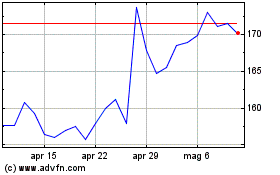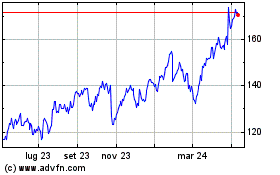Publishers Warm to Google's Ad Blocker, but Chafe at Company's Power
15 Febbraio 2018 - 11:59AM
Dow Jones News
By Benjamin Mullin
Publishers are greeting the launch of Google's ad blocker with a
mixture of relief and unease, pleased that it is purging intrusive
ads but worried over the internet giant's power to quickly overhaul
the industry.
Beginning Thursday, Google Chrome, the world's most popular web
browser, will begin screening advertising formats that fail to meet
standards adopted by the Coalition for Better Ads, a group of
advertising, tech and publishing companies, including Google, a
unit of Alphabet Inc.
"I think getting those bad ads out of the ecosystem is better
for the rest of us who are doing these things well, but it's worth
discussing that one company has that much power over the internet
and what gets monetized," said Neil Vogel, the chief executive of
Dotdash, a digital publisher with sites about topics such as health
and wellness, home improvements and travel.
Sites with unacceptable ad formats -- annoying ads like pop-ups,
auto-playing video ads with sound and flashing animated ads -- will
receive a warning that they're in violation of the standards. If
they haven't fixed the problem within 30 days, all of their ads --
including ads that are compliant -- will be blocked by the browser.
That would be a major blow for publishers, many of which rely on
advertising revenue.
In April, news of Google's planned ad blocker was met with
apprehension from publishers, who worried that the technology would
torpedo their ad-supported websites and services. Many of those
fears have been assuaged. Several publishers were warned months in
advance that their ads were in violation of the standards and have
brought them up to snuff, including the Chicago Tribune, the Los
Angeles Times, The Wrap and In Touch Weekly.
Less than 1% of the web's most-visited sites are set to have
their ads blocked, Google said.
"We are committed to joining with publishers to improve the user
experience online and are encouraged by the hundreds of sites who
have stopped using intrusive ads in the past few months," a Google
spokeswoman said. "Our hope is that Chrome won't have to filter ads
at all."
The decision to curtail junk ads is partly a defensive one for
both Google and publishers. Third-party ad blockers are exploding,
with as many as 615 million devices world-wide using them,
according to some estimates.
Many publishers expressed optimism that eliminating annoying ads
will reduce the need for third-party ad blockers, raise ad quality
and boost the viability of digital advertising.
"As the supply of quality display advertising goes up, buyer
confidence in that inventory will go up and buyers will be
comfortable increasing the dollars they invest in it," said Mike
Smith, senior vice president of revenue platforms and operations
for Hearst Magazines.
Chrome's ad blocker lands in an industry that has had a
love-hate relationship with intrusive ads for years. As factors
like page-load speed have become increasingly important to mobile
users, many publishers have been reassessing whether to clutter
their sites with ads.
The Wrap was already reorganizing the ads on its site last year
when executives there became aware that the entertainment site was
in violation of ad standards developed by the coalition, said Alan
Citron, the site's general manager.
Executives noticed a decline in the amount of readers the site
was getting from search engines, and a consultant said ad clutter
was partially to blame. The site brought its ads up to the
recommended standards, and the search traffic ultimately returned.
He applauded the give-and-take between Google and publishers but
noted that communication hasn't always been this clear.
"We felt good about doing it because it does create a better
experience, " Mr. Citron said. "But we also felt we were wandering
around in the dark a little bit and wondering why these things
weren't okay."
While many publishers dislike intrusive ads, some advertisers
like them, said Harry Kargman, chief executive at the mobile ad
firm Kargo. Ads that take over the entirety of users' screens
before other content has loaded, known as prestitial ads, are
almost always viewed in their entirety by consumers. Prestitial ads
with countdown are banned under the new standards.
Because of the split in the industry, Google is uniquely
positioned to help address concerns over annoying web
advertising.
"Who serves the most ads?" said Jason Kint, chief executive of
the trade group Digital Content Next. "Who has admitted to paying
for the most popular ad block software? Where do most people search
for and install ad block software? The answer to every question is
Google. Of course, this makes the industry uncomfortable. The
silver lining is that Google is also in the best position to fix
their mess."
--Douglas MacMillan contributed to this article.
(END) Dow Jones Newswires
February 15, 2018 05:44 ET (10:44 GMT)
Copyright (c) 2018 Dow Jones & Company, Inc.
Grafico Azioni Alphabet (NASDAQ:GOOG)
Storico
Da Mar 2024 a Apr 2024

Grafico Azioni Alphabet (NASDAQ:GOOG)
Storico
Da Apr 2023 a Apr 2024
